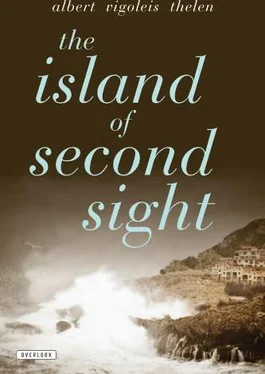Our chair, which was superfluous whenever both of us were in the room, had its firm place up against the wall, where it looked like a hanging epitaph, a Baroque extrusion good for placing objects on. Most often, it was decorated with a tin can containing fresh flowers, and this became a problem when one of us wanted to sit down. I transformed our trunks into chests. Our bidetto is already familiar in its new function, but we of course also cooked on it—“brewed” would be the more fitting word, to take cognizance of its dual role. I stretched our ropes across the area where the architect had left a gaping hole, in the manner of clotheslines, but not for drying clothes. Instead, I hung our library on it, plus items we used during the course of the day. All kinds of things bounced above our heads: shoes, stockings, Georg Trakl, brushes, spoons, Nietzsche, Saint Augustine, dustcloths, suspenders, Novalis, detective novels, brassières, Teresa de Avila, St. John of the Cross — our books astride the ropes à la amazona . Using special wire clips, I took rejected manuscripts and pages fresh from the typewriter and fastened them to the lines, where, like our victuals, they would be more or less safe from the rats. In old-time printshops, as you can see in early woodcuts, they hung the galleys up on ropes in a similar fashion to dry. If you’re willing to blank out such diverse items as sausages, loaves of bread, bags of flour or sugar, a sprig of vanilla, garlic cloves, and bay leaves, you’d think the Clock Tower might be the Venetian printing office of Aldus Manutius.
So now, in place of a missing ceiling, we had an elaborate latticework of lines set out with remarkable skill, one that still allowed us a view of higher things. What writer can boast of a similar working space, where he can receive creative inspiration from above and below at the same time?
Things didn’t go very well for us during these first weeks after the collapse of all the hopes we had set on the bottom of the ocean, and on Victor van Vriesland’s skills as a womanizer. Whoever puts his faith in hoping ought to consider making a careful selection, and eliminate from the start certain questionable aims. But we didn’t complain. We set to hard work — Beatrice with her usual compulsiveness that tastes like “victory,” compared to which I feel like a dullard, even when I’m putting my shoulder to the wheel next to her. Like the ants, grain by single grain we built our abode here in the Tower of Iniquity, surrounded by whores and rats, house searches and braying donkeys, candlelight and pious concupiscence, sharing a glass of wine with Arsenio or gabbing with the old crone. Somehow I even found time to play with the kids and sit on the lookout for the rat-king.
One of the kids in the family, Pablo, was slated to learn English so that he could later play a role in his father’s business, whose true nature was getting gradually unveiled. Pablo was nineteen, narrow-minded, and wily; his hair was shaved down to his skull, and his breath smelled. He was in the military, but he was bought free to the extent that he could sleep at home rather than in a barracks. Three times a week he hunkered down in the Giant’s fonda as Beatrice funneled learning into him. For this activity she received 25 pesetas, meaning that we no longer had to pay rent for our cell. The young soldier, who at nighttime went on life-threatening smuggling duty, fell asleep without fail every time English sounds reached his ears. And since it is inadvisable to waken a sleeping soldier, Beatrice, too, regularly fell asleep during these sessions. It is only very great generals who can afford to snooze on the battlefield. The only one who stayed awake was the Giant. He slithered around our little classroom with something on his mind — but what? Every time Beatrice’s head fell on the tabletop, she woke up with a start and saw this gang leader motioning to her with a shiny duro — his Adeleide wouldn’t notice, and after all, he was the boss here at the Clock Tower. Beatrice could no longer see the forest for the trees, so I finally had to enlighten her as to what this guy really meant by flashing 5 pesetas at her. In my calmest tones I let her know that she had gone down in price since we started living right here at the source. Now that we were housed in a hookshop on the basis of a hotel waiter’s ministrations, it was all over with the prices once offered by the gentlemen sitting on the hotel terrace. Beatrice shook her head, and with this gesture she provided the most plausible confirmation of the effectiveness of my interior architecture: she had forgotten that the air surrounding us was unclean. Then it was Arsenio’s turn to shake his head. He added a second duro, he went as high as twenty, and then he gave up. We stayed the best of friends. He just couldn’t understand why people didn’t make use of their most natural gifts.
Why would a woman ever choose to remain fallow?
After a few months, he offered to advance me the amount due at customs for our books. We could bring all of them here, since books were all that we had on our minds. I thanked him with a deep bow, and was given wine. But we refused his tempting offer, for fear of the rats. We knew that there wasn’t any cheese in those boxes of books, but we didn’t trust for a moment the lemurs in this carnal zoo.
We enjoyed the respect of the permanent Tower whores. They were poor creatures, not all of them beautiful. They were women who got badly mauled by the bullfighters when they wouldn’t perform as requested. Their behavior earned them slaps and blows as a bonus for the love-making. They knew that we could hear everything, and they agreed that the whole setup was like a pigsty. I told one señorita I had got to know, one who had certain intellectual ambitions, that you can get beaten up in any profession: a rejected manuscript is no caress, either. When I showed this girl our room, she broke out in tears. And then she asked if we had ever seen the Big One.
The Big One in the Tower of Whores was the super-lady, the main attraction, a walking exemplar of eroticism, a living legend of lechery, a second Pilar, a scarlet sister of sainted reputation, Palmira by name, who demanded a cool thousand to stretch out on the mattress of her profession — if we can indeed call a “mattress” the venue where she pursued her business. Her johns, if they weren’t the famous espadas in person, arrived in limousines. For this queen of the coquettes, Adeleide had outfitted a luxury chamber in the main house. One day Palmira showed it to us, like a proud newlywed showing her relatives around the estate of her nouveau-riche husband. This suite had cost a pretty penny. The four-poster bed stood on a raised platform, the canopy borne by gilded columns. An elegant mantilla served as a bedspread. By means of a silken sash, the canopy could be opened, revealing a capacious mirror. Indirect illumination was installed all around, each lamp with its own silken pull. The walls were done in Genovese damask. In one corner stood a shrine with an antique Madonna on the crescent moon, a literally adorable figure. There was a censer hanging on a chain, a lamp for the eternal flame, and an ivory crucifix. A reproduction of Goya’s nude Maia , not one clipped from some art book, hung on the wall in an exquisite frame. Above the door you saw a shepherd lolling next to his shepherdess, playing her a tune on his shawm. The room smelled of very expensive lasciviousness. An upholstered door led to the bath, which was a masterpiece of the Palma firm of Casa Buades, Plaza Cort 32–35. Baths of such opulence as this one were to be found in only one other location on the island, the Palacio of the banker Juan March. Pilar’s murrhine receptacle was here made of red marble. It could not be held in the flat of your hand — the single blemish in this exemplary penthouse.
Читать дальше












